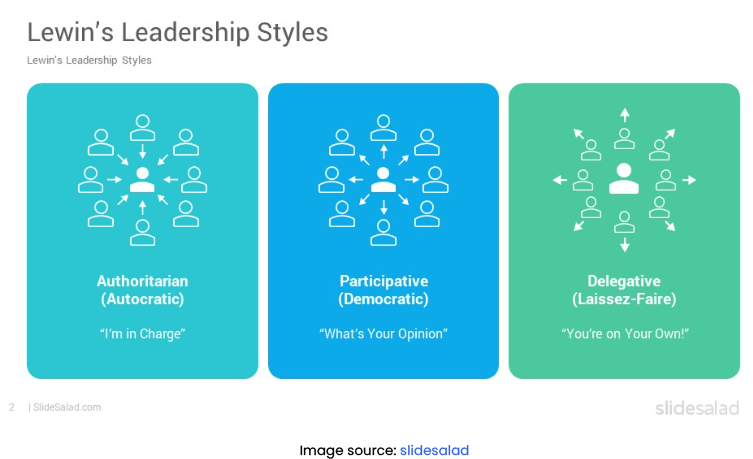
Click the button to start reading
5 Autocratic Leadership Examples to Help You Strike the Perfect Balance
Leadership is the art of balancing.
It’s a tightrope walk where understanding the diverse needs of your team and the specific demands of each task is the key to success.
Picture this: you’re in a high-pressure environment, and quick decisions are the only way out. In such moments, an autocratic leadership style might be just what you need.
But there’s a catch. While it may deliver results, it could leave your team feeling undervalued and unmotivated. As a result, it may affect their productivity and morale.
So join us as we dive into the pros and cons of autocratic leadership and explore autocratic leadership examples. In the end, you’ll be able to decide whether the autocratic leadership style is right for your business.

What Is Autocratic Leadership?
Autocratic leadership is when a single person takes charge and makes decisions without asking others for their input. It’s a style where one person holds the reins and makes most of the decisions.
Autocratic leaders set goals for the group, assign tasks, and make choices based on their own beliefs and experiences. In other words, the leader is the “bossy boss” who likes to be in charge of everything.
The Origins of Autocratic Leadership
The term “autocratic leadership” comes from the Greek word “autokratia,” where “auto” means “self” and “kratos” means “power” or “rule.”
It originally referred to a system of government where one person held all the power. Also, he made decisions without the need to consult or involve others.
Comparing Leadership Styles: Autocratic, Democratic, and Laissez-Faire
Over time, this concept of autocratic rule was applied to leadership styles in various settings.
In the 1930s, a psychologist named Kurt Lewin came up with the term ‘autocratic leadership’. He compared it with two other styles: democratic and laissez-faire.

Autocratic (Authoritarian) Leadership. In the autocratic leadership style, the leader makes decisions without involving others much. They have full control and authority over the team and usually don’t seek opinions from their members. The leader gives direct orders and expects immediate compliance from the team. Here, there’s little room for discussion or creative input. If you’re attentive, you’ll notice autocratic leadership examples in business quite frequently. We’ll discover some of those examples in a minute.
Democratic (Participative) Leadership. Have you ever been in a team where the leader encourages open communication and asks for your input? That’s the democratic leadership style in action! Here, the leader involves the team members in decision-making. Different viewpoints are considered before making choices.
Laissez-Faire (Delegative) Leadership. Team members have the most freedom when the leadership style is delegative. To explain, the leader provides minimal guidance and lets the team largely manage themselves. In this case, the leader is like a coach who trusts their players to come up with their tactics during a game.
Examples of the Autocratic Leadership Style
The autocratic leadership style, in fact, has different shades. Let’s look into them for better insight:
So, there are three main examples of autocratic leadership style:
Directing (rigid). This type involves a leader who is firm and inflexible in their decisions. They provide clear instructions and expect strict adherence from their team.
Permissive (slightly more flexible). In this style, the leader still maintains control but allows some room for discussion and input from team members. But the final decisions rest with the leader.
Paternalistic (strict but caring). This approach strikes a balance between being strict and caring. The leaders consider the well-being of the team and may involve them in decision-making. But they still maintain authority.

Pros of Autocratic Leadership
While this style may not suit every situation, it does have some advantages:
- Quick Decision-making. Autocratic leaders can make decisions faster because they don’t have to gather opinions from everyone. This can be helpful in urgent or time-sensitive situations. During times of crisis, autocratic leadership examples may emerge, as leaders need to act quickly to find a solution.
- Clear Direction and Efficiency. With one person making most of the decisions, there’s a clear direction for the company. Employees know what’s expected of them and where they’re heading. Besides, since the leader sets strict rules, it may reduce confusion and delays.
- Strong Leadership. Autocratic leaders often have a strong presence and can take charge effectively. This can provide a sense of stability and confidence within the company.
- Centralized Control. Autocratic leadership allows for centralized control, which can prevent conflicts among team members.
- Suitable for Certain Industries. Some industries require strict hierarchies and rapid decisions. The military or certain manufacturing sectors are vivid examples. Autocratic leadership can be well-suited to these environments.
1. Example of an Autocratic Leadership Style Being Highly Effective
A well-known example of an autocratic leadership style being effective in the business world is Henry Ford.
Henry Ford was known for his strong autocratic leadership during the early years of the company’s growth. He had a clear vision for the mass production of affordable automobiles. And particularly the Model T, which revolutionized the automotive industry.
Here are some ways in which Henry Ford’s autocratic leadership style was effective:
Firstly, Ford introduced the assembly line technique, where each worker had a specific job. This made the production of the Model T much faster and cheaper.
Secondly, he had a clear focus on making the Model T affordable for ordinary people. This helped the company stay on track and do well.
Another important aspect of his leadership was quick decision-making. He made important decisions about the company’s direction and how to make cars faster than competitors.
Also, Ford made sure that the production process was consistent and reliable. He set strict standards and quality control measures, which made the Model T known for its reliability.
Despite being an autocratic leader, Ford encouraged innovation and invention in his company. This led to continuous improvements in how they made cars and the features they offered.
Thus, Henry Ford’s autocratic leadership brought efficiency and innovation to Ford Motor Company. That’s how the company has become a dominant force in the automotive industry.
Cons of Autocratic Leadership
Autocratic leadership, like any style, has its drawbacks. Let’s look at some of the cons:
- Low Employee Morale. In an autocratic-led company, employees may feel less motivated and engaged. Since they have limited input and decision-making power, they might not feel valued or appreciated.
- Creativity and Innovation Limitations. Autocratic leaders tend to have the final say on most matters, which can stifle creativity and innovative thinking. Employees may not feel comfortable sharing new ideas.
- Communication Issues. With limited two-way communication, important information might not reach the leader. As a result, employees might not fully understand the reasoning behind decisions.
- High Turnover. Autocratic leadership examples often result in higher employee turnover. Employees who feel unheard or restricted in their roles may seek opportunities elsewhere. Ultimately, this may lead to higher turnover rates.
- Resistance to Change. Employees might resist changes. And that’s natural. If they aren’t involved in the decision-making process, they view all solutions as being imposed by the leader.
- Dependency on the Leader. An autocratic-led company can become overly dependent on the leader. If the leader leaves or becomes unavailable, it may lead to disruptions in decision-making.
By the way, a survey by Leadership IQ showed that 38% of people prefer leaders who involve their teams in decision-making. So, the ‘command and control’ style isn’t as popular as democratic or participative leadership.
2. Example of an Autocratic Leadership Style that Has Gone Wrong
A real-life example of an autocratic leadership style with harmful consequences is the case of Theranos. A biomedical company founded by Elizabeth Holmes. She adopted an autocratic approach, not encouraging transparency or listening to employee concerns. This led to problems like ignoring important issues and inaccurate technology claims. The lack of openness also caused legal and ethical troubles, with investigations and lawsuits over false claims.
What’s more, the autocratic style created a culture of fear and mistrust among employees. As a result, many employees left, making it hard to find skilled professionals to join the company.
In the end, the autocratic leadership style contributed to Theranos’ downfall. There was even legal and reputational damage after the truth about the technology’s failure came to light. Elizabeth Holmes faced criminal charges due to the false claims made by the company.
Thus, the story of Theranos serves as a cautionary example of an autocratic leadership style. Firstly, it shows how the wrong type of leadership can stop people from talking. Secondly, it reminds us of the importance of allowing people to take responsibility.

Examples of Autocratic Leadership in Business
3: Steve Jobs (Apple Inc.)
Steve Jobs was known for his autocratic leadership style, which was often compared to a dictator. Jobs had a keen eye for detail and surrounded himself with like-minded people who shared his vision. While his clear direction helped Apple succeed, some saw his forceful style as a problem. He made quick decisions and didn’t always listen to his team’s ideas.
In simpler terms, Jobs believed in “my way or the highway.” He thought he was solely responsible for the team’s choices and didn’t focus much on collaboration. Despite criticism, his leadership style drove Apple to great success and left a lasting impact on the tech industry.
4. Elon Musk (Tesla, SpaceX, etc.)
Elon Musk, the CEO of Tesla, SpaceX, and other companies, has been described as having an autocratic leadership style. He’s known for expecting a high level of dedication from his teams.
Elon Musk’s autocratic leadership style was evident in his handling of the production challenges faced by Tesla. Musk reportedly made critical decisions independently and sometimes clashed with his team. As a result, it led to a high-pressure work environment and employee turnover.
Elon Musk’s way of leading has been closely examined, and some people say it’s like an autocratic style. He tends to make important decisions on his own without much input from others.
He has a strong vision and sets big goals for his companies, which shows his autocratic tendencies. Because of this, he expects a lot from his employees and can be very demanding, creating a tough work environment.
Also, Musk gets involved in many details and likes to control things closely, which adds to the impression of an autocratic leader. He communicates directly and honestly, but he doesn’t tolerate failure well.
5. Larry Ellison (Oracle Corporation)
Larry Ellison, the co-founder and former CEO of Oracle Corporation, has been seen as an autocratic leader. He was known for being assertive and maintaining a strong hold on the company’s direction.
Some people criticize him for this controlling and inconsiderate approach. But he seems to take pride in it, modeling his leadership after samurai principles.
While his approach may not involve much input from others, he believes his decisions are what’s best for everyone involved.

Is Autocratic Leadership Your Best Choice?
Deciding on the right leadership style for your company or team is crucial, and there’s no one-size-fits-all answer. It depends on various factors, including your team’s dynamics, the nature of the tasks, and your team members’ preferences.
If your team works well with clear direction and needs quick decisions, an autocratic leadership style might be suitable. It can be helpful in emergencies or when there’s not much time for lengthy discussions.
But if your team values collaboration, a more participative or democratic leadership style might be better. This style is about including your team in decision-making, which helps them take ownership of their work.
You could also consider using a combination of leadership styles, adapting your approach based on the situation at hand. For example, during a crisis, an autocratic style might be necessary. But in everyday operations, a more inclusive approach could result in improved teamwork and innovation.
Leading Towards the Future…
When things get tough, we need leaders who can make quick decisions and provide stability.
That’s why leadership styles change with time and circumstances.
Today, organizations focus more on working together and empowering their employees. This means leadership is becoming more inclusive and collaborative. And most probably, we’ll see fewer autocratic leadership examples in the future.
What’s more, project management tools like Teamly help leaders collaborate better with their teams. They make handling projects much easier. Plus, they break down communication barriers using advanced features and coordinate tasks smoothly.
Remember, the best leaders adapt their style to fit the needs of their team. By being flexible, leaders can guide their teams to success. Ultimately, they can create a bright future for their organizations and make a positive impact.
















